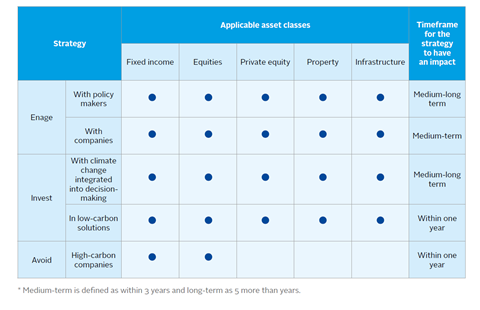The following groups need to be engaged to decide on appropriate strategies: senior decision makers, beneficiaries and stakeholders, and portfolio managers.
Senior executives and non-executive decision makers
Early discussions with the Board, Trustees and Chief Investment Officer can cover:
- The case for action on climate change, focusing on climate science implications, fiduciary duty, alignment with the investment horizon and liabilities;
- An overview of possible strategies (engage, invest and avoid), including discussing consistency with investment objectives and the risk/volatility appetite of the endbeneficiaries, as well as how peers are responding to climate change;
- Potential implications for asset allocation and portfolio managers; and
- Any new performance indicators for monitoring and evaluating success.
Beneficiaries and stakeholders
The fast-moving public debate on climate change makes it important to engage with beneficiaries, staff, supporters (in the case of charities) and external stakeholders. Asset owners need to communicate with members on climate change risks associated with their investments and how these are being managed in line with their long-term interests. Mechanisms could include:
- Surveys, focus groups, workshops, member annual general meetings or events focused on climate change;
- Communication through regular reporting and social media on proposed strategies.
Portfolio managers
Early dialogue with portfolio managers is essential to deciding and executing actions on climate change which ever strategy the investor considers appropriate. This may include understanding a portfolio manager’s capacity to: conduct portfolio carbon footprinting and/or other kinds of risk assessment evaluation processes, engage with companies and policy makers, conduct integrated analysis, or consider options for low carbon-themed investment or reallocation from high carbon holdings.
Passive managers
Passive investment can reduce carbon risk by creating separate accounts or index strategies that tilt portfolios towards lower carbon assets or through measurement. Exclusion and reallocation will be more complex for a passive manager to implement if not using separate accounts. Passive managers can also implement an engagement strategy.
External portfolio managers
Discussions in performance review meetings or in written correspondence, may cover which investment activities have already been undertaken to respond to climate change risk and opportunity. Specific areas to discuss may include:
- Climate change risk and opportunities: what kind of sectoral, stranded assets or other analysis can be used to understand exposure to climate change risks and opportunities?
- Emissions measurement: what emissions monitoring can be undertaken, such as carbon footprinting, and how can the findings be used?
- Engagement: what kind of voting and engagement with companies and policy makers can be undertaken?
- Investment: how can the investment process be developed to incorporate climate change risk and opportunity at a sector- and company-level?
- Avoidance: could reallocation or reduced portfolio exposure to emissions be incorporated, and with what implications for the fund and how it is managed? What is the current fossil fuel exposure of the fund compared to the benchmark?
Existing mandates
Discussions could include how managers can evolve their approach to meet new requirements over an agreed time period. Portfolio managers and consultants will need to formally review any new strategies for risk management or emissions reduction impacting on the mandate. They will need to give a clear view on the implications for asset allocation, the investable universe, tracking error, liquidity, time horizons and financial return expectations, as well as the portfolio manager’s capability to meet the new requirements. Portfolio managers will need to affirm their willingness to work with their asset owners on significant new requirements.
Selecting, appointing and monitoring managers
Including climate change-related requirements in these processes is an important way to ensure that expectations are clear and delivered on.
- Selection: Requests for proposals, questionnaires, discussions and any requests for evidence or examples can cover climate change requirements, as can any evaluation criteria used to select managers.
- Appointment: Contract terms within investment management agreements can include climate changerelated requirements, as can side letter agreements.
- Monitoring: Evaluation frameworks can incorporate climate change-related performance indicators. Agreements can specify the nature and frequency of reporting.
Download the full report
-

Developing an asset owner climate strategy
November 2015
Choose appropriate strategies and execute them - engage, invest, avoid
There are a variety of options available to asset owners seeking to reduce exposure to climate risk and encourage the transition to a low carbon economy. In deciding on appropriate strategies, asset owners can draw on the framework below covering three main strategies: engage, invest and avoid. The summary table highlights that most opportunities to contribute towards emissions reduction are applicable to every asset class.
Engage
Public policy affects the sustainability and stability of financial markets; policy engagement is therefore a natural and necessary extension of an investor’s fiduciary duties to the interests of beneficiaries. On climate change, supportive public policy is essential to levelling the playing field for new forms of energy and energy efficiency, and for scaling up low-carbon investment. For more on this see PRI’s 2014 publication, The Case for Investor Engagement on Public Policy.
Investor engagement with companies is a critical tool for encouraging an orderly transition to a low-carbon economy.
Invest
Integrate climate change into investment decision-making and identify low-carbon opportunities. Carbon is a risk that needs to be considered within investment analysis, including in analysing company value in equity investing and assessing credit risk in fixed income.
Low-carbon investment opportunities include “green” infrastructure, climate and green bonds, as well as positive or thematic sustainable investing in public and private equity.
Avoid
Investments could be avoided, through screening or reallocation, for reasons such as financial risk, where dialogue with companies does not succeed, for market signalling, or for alignment with an asset owner’s specific mission.
Download the full report
-

Developing an asset owner climate strategy
November 2015
Developing an asset owner climate change strategy
- 1
- 2
- 3
Currently reading
Step two: act
- 4
- 5
- 6
- 7















